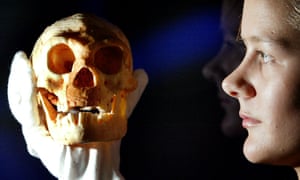article published in the "Guardian" January 14th 2016
Sulawesi find: 118,000-year-old stone tools point to 'archaic group of humans'
Discovery of 311 implements on Indonesian island suggest modern
humans settling there 60,000 years ago would have met an ‘isolated human
lineage’

The diminutive prehistoric human species dubbed the “Hobbit” that inhabited the Indonesian island of Flores long before the arrival of Homo sapiens apparently had company on other islands.
Stone tools that are at least 118,000 years old have been discovered on the island of Sulawesi, indicating a human presence, scientists said on Wednesday. No fossils of these individuals were found in conjunction with the tools at the site called Talepu, leaving the toolmakers’ identity a mystery.
“We now have direct evidence that when modern humans arrived on Sulawesi, supposedly between 60,000 and 50,000 years ago and aided by watercraft, they must have encountered an archaic group of humans that was already present on the island long before,” said archaeologist Gerrit van den Bergh from the University of Wollongong in Australia.
“Like on Flores, where Homo floresiensis evolved under isolated conditions over a period of almost 1m years, Sulawesi could also have harboured an isolated human lineage. And the search for fossil remains of the Talepu toolmaker is now open,” van den Bergh said.
The researchers described 311 stone tools, most made of a very hard limestone. Archaeologist Adam Brumm of Australia’s Griffith University said they were produced by humans striking one stone with another, fashioning smaller pieces with knife-like sharpness.
“They mostly comprise simple sharp-edged flakes of stone that no doubt would have been useful for basic tasks like cutting up meat, shaping wooden implements, and so on,” Brumm said.
Found nearby were fossils of an extinct elephant relative and extinct giant pig with warthog-like tusks.
The 2004 announcement of the discovery in a Flores cave of fossils of Homo floresiensis – a species about 1.1m (3ft 6in) tall that made tools and hunted little elephants – jolted the scientific community.
Scientists have been eager to unravel the region’s history of human habitation. Sulawesi may have served as a stepping stone for the first people to reach Australia roughly 50,000 years ago.
Aucun commentaire:
Enregistrer un commentaire